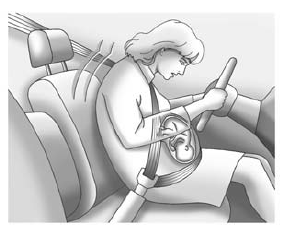Chevrolet Spark Owners Manual: Safety Belt Use During Pregnancy
Safety belts work for everyone, including pregnant women. Like all occupants, they are more likely to be seriously injured if they do not wear safety belts.

A pregnant woman should wear a lap-shoulder belt, and the lap portion should be worn as low as possible, below the rounding, throughout the pregnancy.
The best way to protect the fetus is to protect the mother. When a safety belt is worn properly, it is more likely that the fetus will not be hurt in a crash. For pregnant women, as for anyone, the key to making safety belts effective is wearing them properly.
 Lap-Shoulder Belt
Lap-Shoulder Belt
All seating positions in the vehicle have a lap-shoulder belt.
The following instructions explain how to wear a lap-shoulder belt properly.
Adjust the seat, if the seat is adjustable, so you can ...
 Safety Belt Extender
Safety Belt Extender
If the vehicle's safety belt will fasten around you, you should use it.
But if a safety belt is not long enough, your dealer will order you an extender.
When you go in to order it, take the hea ...
Other materials:
Connecting a USB Storage Device or iPod/iPhone
To connect a USB storage device, connect the device to the USB port.
To connect an iPod/iPhone, connect one end of the device’s cable to the iPod/iPhone
and the other end to the USB port.
The iPod/iPhone charges while it is connected to the vehicle if the vehicle is
in ACC/ACCESSORY, ON/RUN. S ...
If a Tire Goes Flat
This vehicle has a tire sealant and compressor kit. See Tire Sealant and Compressor
Kit on page 10-56.
There is no spare tire, no tire changing equipment, and no place to store a tire.
It is unusual for a tire to blow out, especially if the tires are maintained
properly. See Tires on page 10-3 ...
OnStar Additional Information
Transferring Service
Press to request account transfer
eligibility information. The Advisor can assist in canceling or removing account
information.
Selling/Transferring the Vehicle
Call 1-888-4-ONSTAR immediately to terminate your OnStar services if the vehicle
is disposed of, sold, trans ...
